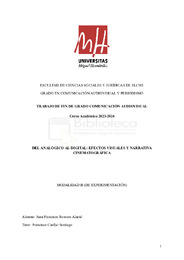Please use this identifier to cite or link to this item:
https://hdl.handle.net/11000/33499Full metadata record
| DC Field | Value | Language |
|---|---|---|
| dc.contributor.advisor | Cuellar Santiago, Francisco | - |
| dc.contributor.author | Romero Alacid, Juan Francisco | - |
| dc.contributor.other | Departamentos de la UMH::Ciencias Sociales y Humanas | es_ES |
| dc.date.accessioned | 2024-10-15T09:25:46Z | - |
| dc.date.available | 2024-10-15T09:25:46Z | - |
| dc.date.created | 2024-06 | - |
| dc.identifier.uri | https://hdl.handle.net/11000/33499 | - |
| dc.description.abstract | Este trabajo de fin de grado (TFG) examina la evolución de los efectos visuales (VFX) desde sus inicios hasta la actualidad, centrándose en la transición del formato analógico al digital y su impacto en la integración de elementos CGI. A través de una revisión histórica, se destacan hitos clave en el desarrollo de los VFX, desde técnicas ópticas tradicionales hasta sofisticadas herramientas digitales. El estudio incluye una experimentación práctica donde se comparan planos grabados en formatos analógico y digital, integrando un mismo elemento 3D en ambos. Los resultados muestran que la integración en digital es más sencilla y precisa, gracias a las herramientas actuales que permiten una mayor exactitud y eficiencia. En contraste, el formato analógico enfrenta mayores desafíos, como problemas de alineación y tracking de cámara, que resultan en inconsistencias visuales. Sin embargo, se observa que el formato analógico aporta una calidad estética y emocional única, debido a sus imperfecciones y fallos técnicos, que pueden enriquecer la narrativa. Esto es evidente en la percepción cultural de vídeos de baja calidad asociados con fenómenos paranormales, donde los defectos técnicos aumentan la verosimilitud. Además, se destaca la importancia de las referencias visuales en la integración. Aunque el formato digital facilita la integración técnica, el formato analógico ofrece un valor narrativo significativo. La elección del formato debe considerar tanto la precisión técnica como el impacto emocional y estético deseado, proponiendo una posible coexistencia y valorización de ambas técnicas en el cine contemporáneo. | es_ES |
| dc.description.abstract | This final degree project (TFG) examines the evolution of visual effects (VFX) from their beginnings to the present day, focusing on the transition from analog to digital format and its impact on the integration of CGI elements. Through a historical review, key milestones in the development of VFX are highlighted, from traditional optical techniques to sophisticated digital tools. The study includes a practical experiment comparing footage shot in both analog and digital formats, integrating the same 3D element into both. The results show that digital integration is simpler and more precise, thanks to current tools that allow for greater accuracy and efficiency. In contrast, the analog format faces greater challenges, such as alignment and camera tracking issues, resulting in visual inconsistencies. However, it is observed that the analog format offers a unique aesthetic and emotional quality due to its imperfections and technical flaws, which can enrich the narrative. This is evident in the cultural perception of low-quality videos associated with paranormal phenomena, where technical defects enhance verisimilitude. Additionally, the importance of visual references in integration is highlighted. While the digital format facilitates technical integration, the analog format provides significant narrative value. The choice of format should consider both technical precision and the desired emotional and aesthetic impact, proposing a possible coexistence and appreciation of both techniques in contemporary cinema. | es_ES |
| dc.format | application/pdf | es_ES |
| dc.format.extent | 59 | es_ES |
| dc.language.iso | spa | es_ES |
| dc.publisher | Universidad Miguel Hernández de Elche | es_ES |
| dc.rights | info:eu-repo/semantics/openAccess | es_ES |
| dc.rights | Attribution-NonCommercial-NoDerivatives 4.0 Internacional | * |
| dc.rights.uri | http://creativecommons.org/licenses/by-nc-nd/4.0/ | * |
| dc.subject | Efectos visuales | es_ES |
| dc.subject | Analógico | es_ES |
| dc.subject | Digital | es_ES |
| dc.subject | CGI | es_ES |
| dc.subject | Narratividad | es_ES |
| dc.subject | Visual effects | es_ES |
| dc.subject | Analog | es_ES |
| dc.subject | Narrativity | es_ES |
| dc.subject.other | CDU::7 - Bellas artes::77 - Fotografía. Cinematografía | es_ES |
| dc.title | Del analógico al digital: efectos visuales y narrativa cinematográfica | es_ES |
| dc.type | info:eu-repo/semantics/bachelorThesis | es_ES |

View/Open:
CAU_TFG_ROMERO_ALACID_JUANFRANCISCO.pdf
12,06 MB
Adobe PDF
Share:
.png)
